Whether you are a nature enthusiast, an art lover, or simply seeking a creative outlet, these fun illustrations of parrots will captivate your imagination. In this article, we explore a collection of delightful parrot coloring pages that offer a perfect opportunity to relax, unleash your inner artist, and immerse yourself in the colorfully educational beauty of these magnificent birds. From their distinctive feathers to their playful personalities, parrots have long been admired and cherished as fascinating creatures. Let’s fly into the fascinating world of parrot coloring sheets and let our creativity take flight!
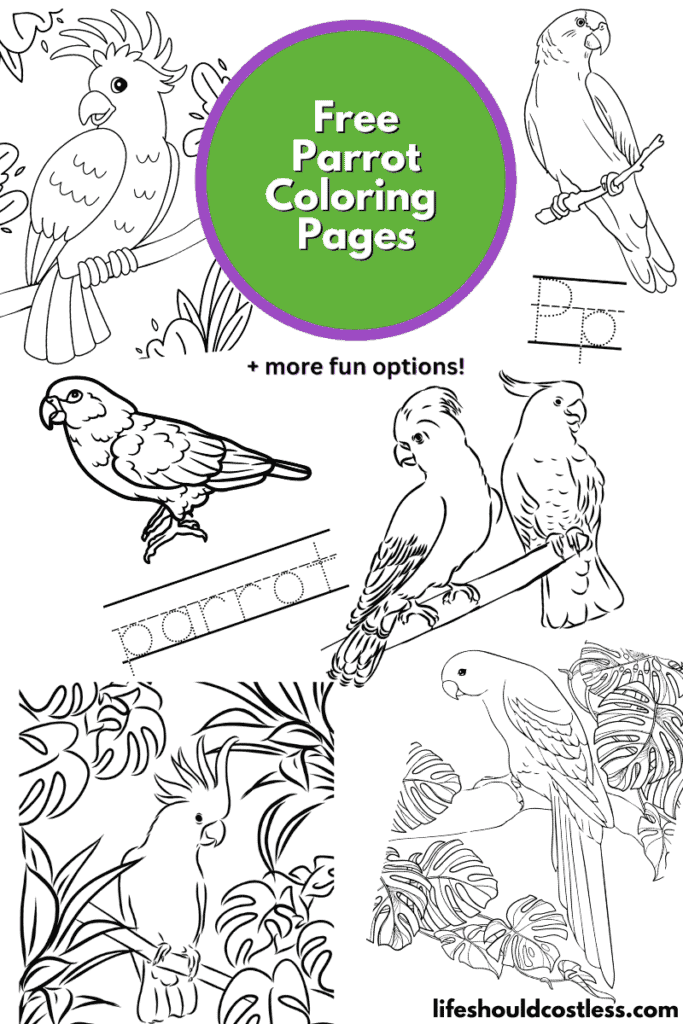
Feel free to choose any design that appeals to you.
Simply select the preferred design, download the free PDF template, print it, and enjoy coloring to your heart’s delight.
Alternatively, you can use these designs as embroidery patterns or draw inspiration for those fine line tattoos.
Parrot facts
For those who are new to my coloring pages, it’s important to mention that I provide the opportunity to learn about the subject, enabling you to effortlessly transform the activity into an educational lesson.
So, let’s dive in and get started with the enriching experience!
Here are some fun and interesting, simplified, facts about parrots (reference source is found here):
- Parrots are highly intelligent birds known for their exceptional ability to mimic sounds, including human speech. Some parrot species can learn and replicate hundreds of words and phrases.
- They belong to the order Psittaciformes, which includes approximately 393 species, ranging from the tiny pygmy parrots to the majestic macaws.
- Parrots are found in tropical and subtropical regions around the world, primarily in Central and South America, Africa, Asia, and Australia.
- These birds have a remarkable lifespan, with some parrot species living up to 80 years or more in captivity.
- Parrots have strong beaks designed for cracking nuts and seeds, which make up a significant portion of their diet. However, their diet can also include fruits, flowers, insects, and even small vertebrates.
- Many parrots are brightly colored, showcasing vibrant hues of blue, green, red, and yellow. These colorful feathers help them blend into their natural environment or attract potential mates.
- Parrots are social creatures that often form strong pair bonds and engage in flock behavior. They communicate with each other through various vocalizations, body language, and displays.
- Some parrot species, such as the famous African grey parrot, have demonstrated remarkable cognitive abilities, problem-solving skills, and the capacity to understand abstract concepts.
- Parrots are known for their playful and curious nature. They enjoy interacting with toys, solving puzzles, and engaging in activities that stimulate their minds.
- Certain parrot species, like the kea from New Zealand, have displayed a mischievous streak and are known for their inclination to investigate and playfully interact with objects, including human belongings.
- Parrots are excellent fliers and have strong wing muscles that allow them to maneuver swiftly through dense forests and open spaces.
- Conservation efforts are crucial for many parrot species due to habitat destruction, illegal pet trade, and the introduction of non-native species. Some parrots, such as the Spix’s macaw, have become critically endangered or even extinct in the wild.
- Parrots have zygodactyl feet, meaning they have four toes on each foot, with two toes pointing forward and two toes pointing backward. This foot structure provides them with a strong grip, aiding in climbing and manipulating objects.
- Some parrot species, like the kakapo from New Zealand, are flightless. They have adapted to a ground-dwelling lifestyle, using their wings for balance and jumping rather than flying.
- Parrots are monogamous birds, often forming long-term pair bonds. Mated pairs engage in activities such as mutual preening and feeding each other as a display of affection and strengthening their bond.
- In addition to their vocal abilities, parrots communicate through various visual cues. They use body postures, head movements, and feather ruffling to express their emotions, intentions, and establish social hierarchies within their flock.
- Parrots have a unique way of consuming food known as “zombie-like” behavior. Some parrots, such as the New Zealand kea, feed on the fatty tissues of dead animals, including carcasses and bones, which is uncommon among birds.
These are just a few of the fascinating facts about parrots that make them truly captivating creatures in the avian world.
If you would like to continue learning about them, here are some other reputable resources to learn about parrots while coloring:
- https://www.smithsonianmag.com/science-nature/14-fun-facts-about-parrots-180957714/
- https://www.forbes.com/sites/grrlscientist/2019/09/19/thinking-like-a-parrot-how-do-parrots-view-the-world/
- https://www.wikihow.com/Train-a-Parrot
- To see all of my free printables, go here.
- To see an alphabetized index of all of my coloring pages, go here.
- To see all of my Animals coloring pages, go here.
- To see all of my Birds coloring pages, go here.
Coloring tips
When it comes to coloring a picture of a parrot, here are some tips and tricks to help you create vibrant and visually appealing artwork:
- Reference Images: Use reference images of parrots to observe their natural colors and patterns. This will help you accurately depict the species you are coloring, and add realism to your artwork.
- Color Selection: Parrots come in a wide range of colors. Consider using bright and bold colors to capture the vibrancy of their plumage. Experiment with different color combinations to make your artwork visually striking.
- Layering and Blending: To achieve depth and dimension, try layering multiple shades of the same color or blending different colors together. This technique can add richness and texture to the feathers of the parrot.
- Highlights and Shadows: Pay attention to the light source in your artwork. Add highlights with lighter shades of color to areas that catch the light, while using darker shades or crosshatching to create shadows. This technique can make the parrot appear more three-dimensional.
- Texture and Details: Parrots have unique feather patterns and textures. Use various techniques, such as small strokes, dots, or lines, to mimic the texture of their feathers. This attention to detail can bring your artwork to life.
- Experiment with Mediums: Explore different coloring mediums like colored pencils, markers, or watercolors. Each medium offers its own set of advantages and effects. Experiment with different techniques and find the medium that suits your style and preferences.
- Background and Composition: Consider the overall composition of your artwork. Choose a suitable background that complements the colors of the parrot. It could be a simple solid color, a natural habitat, or an abstract design that enhances the visual impact of the parrot.
- Practice and Patience: Coloring is a skill that improves with practice. Don’t be discouraged if your first attempts don’t turn out as expected. Keep practicing, be patient with yourself, and enjoy the process of exploring and improving your coloring techniques.
Remember, the most important aspect of coloring is to have fun and let your creativity soar.
Embrace your own artistic style and enjoy the experience of bringing these magnificent birds to life on paper.
Options For Printing:
Letter P is for parrot writing practice worksheets
*My letter P is for parrot coloring sheet printables are specifically designed to be used in a classroom setting, they are the only printable options on this page that do not need written permission to use in a public setting.
Please send the link to this post along if anyone asks you where you got them. Thank you!
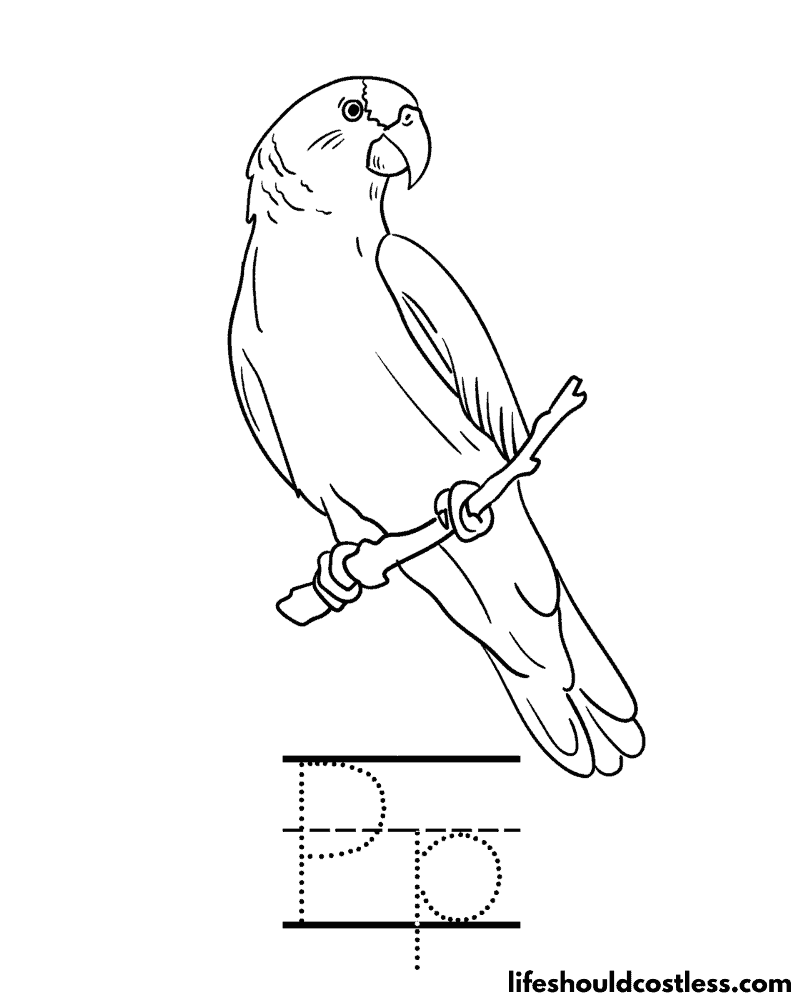
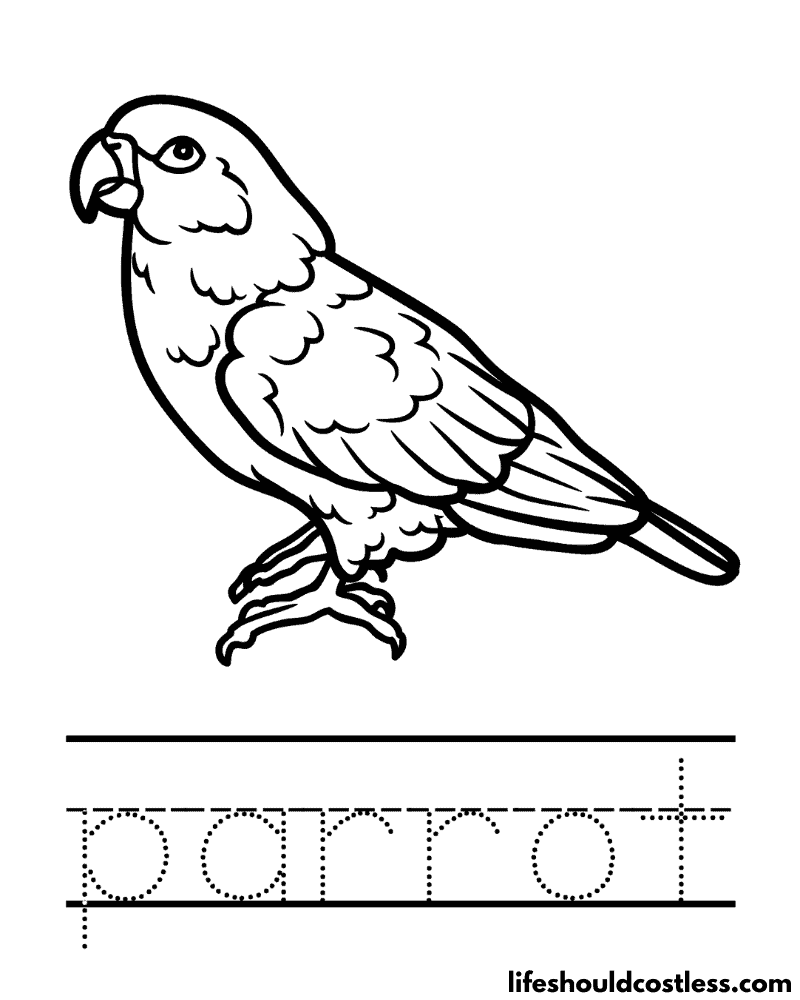
Realistic Parrots
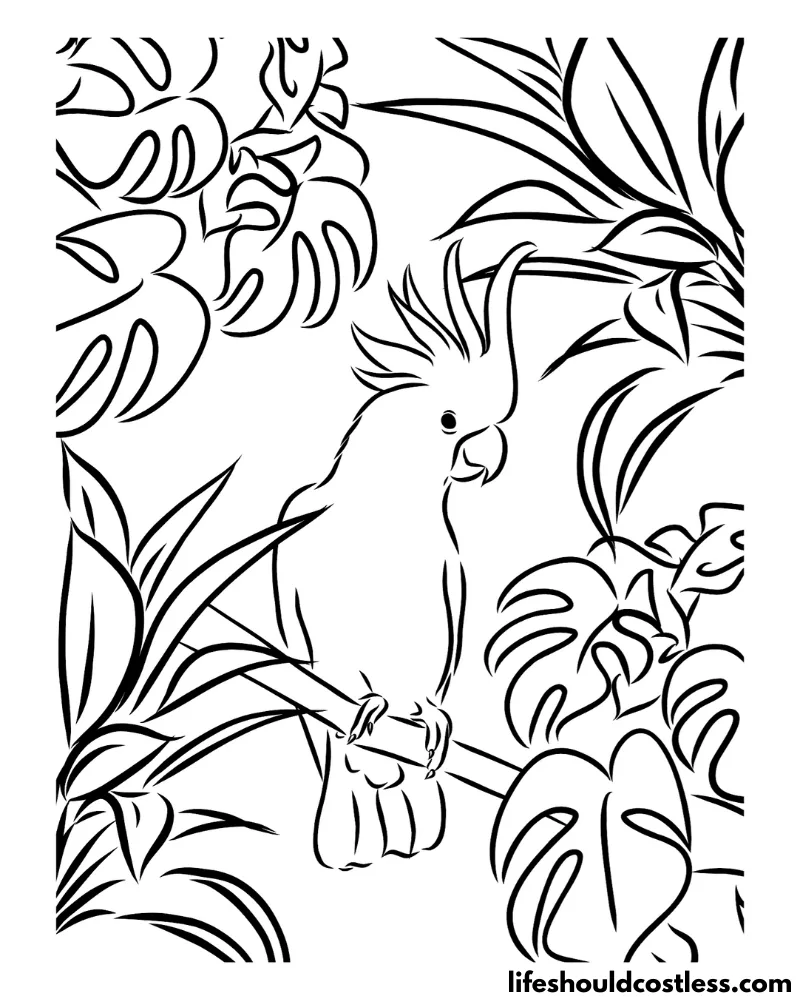
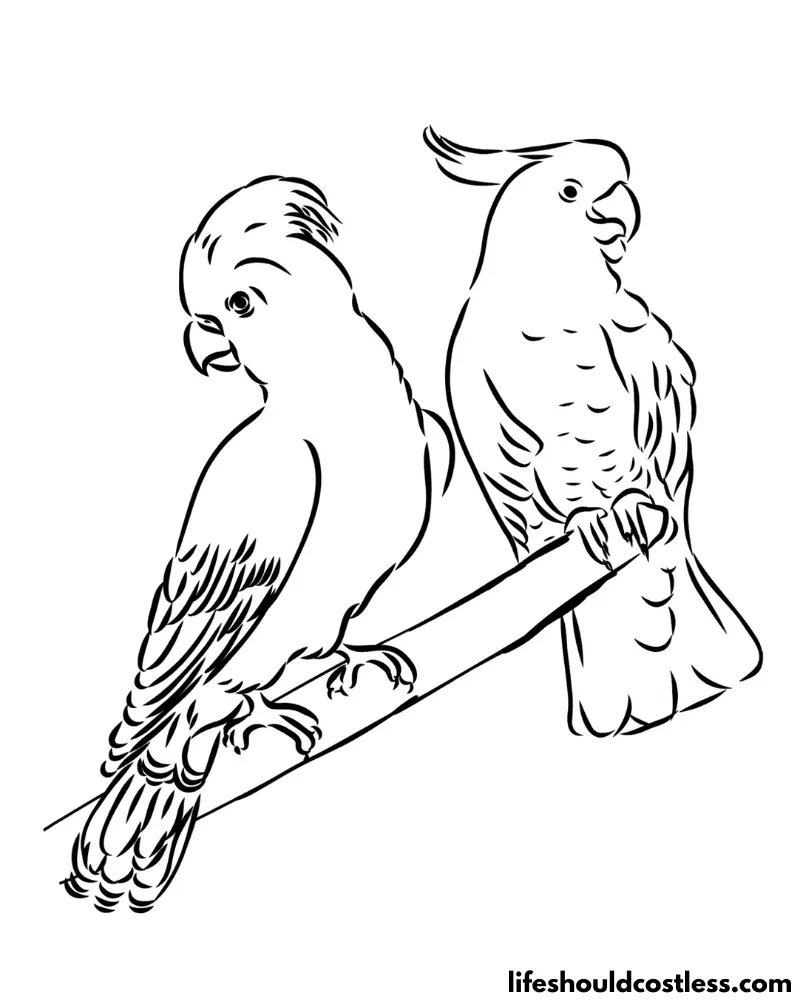
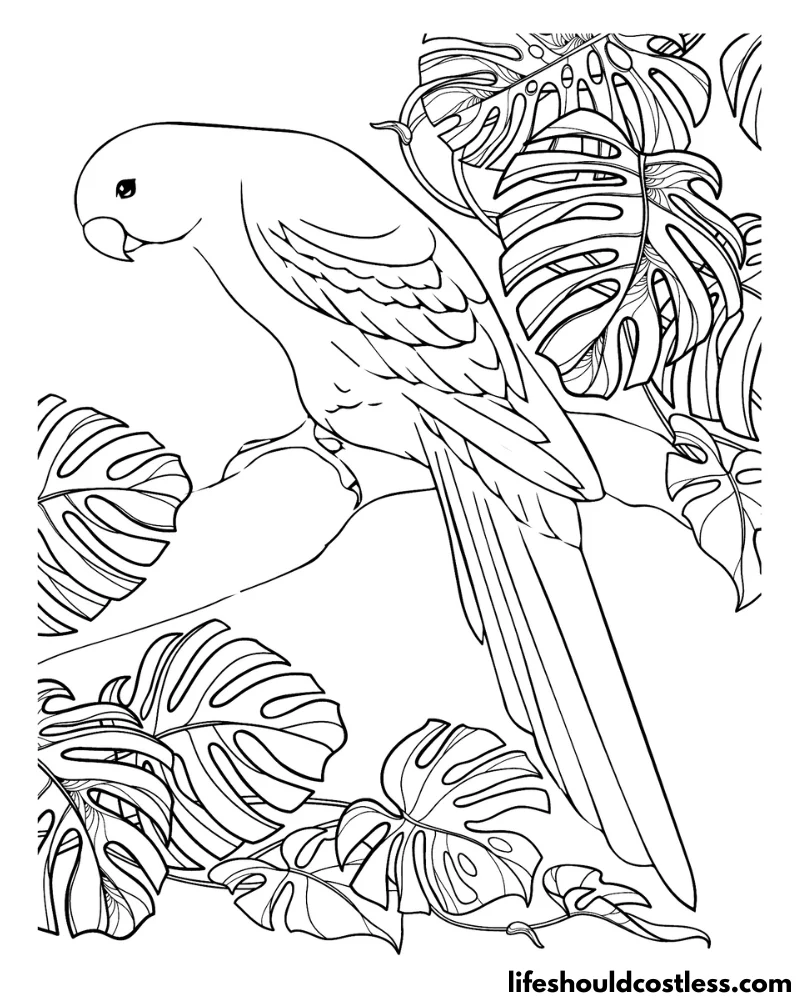
Misc Parrots To Color
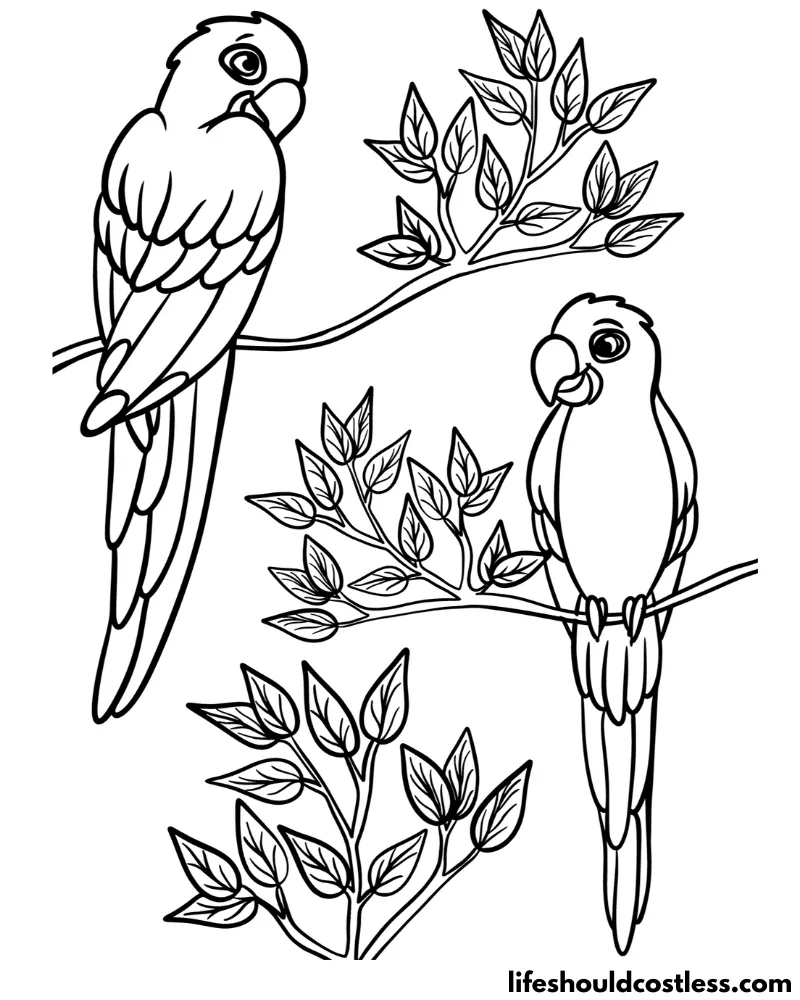
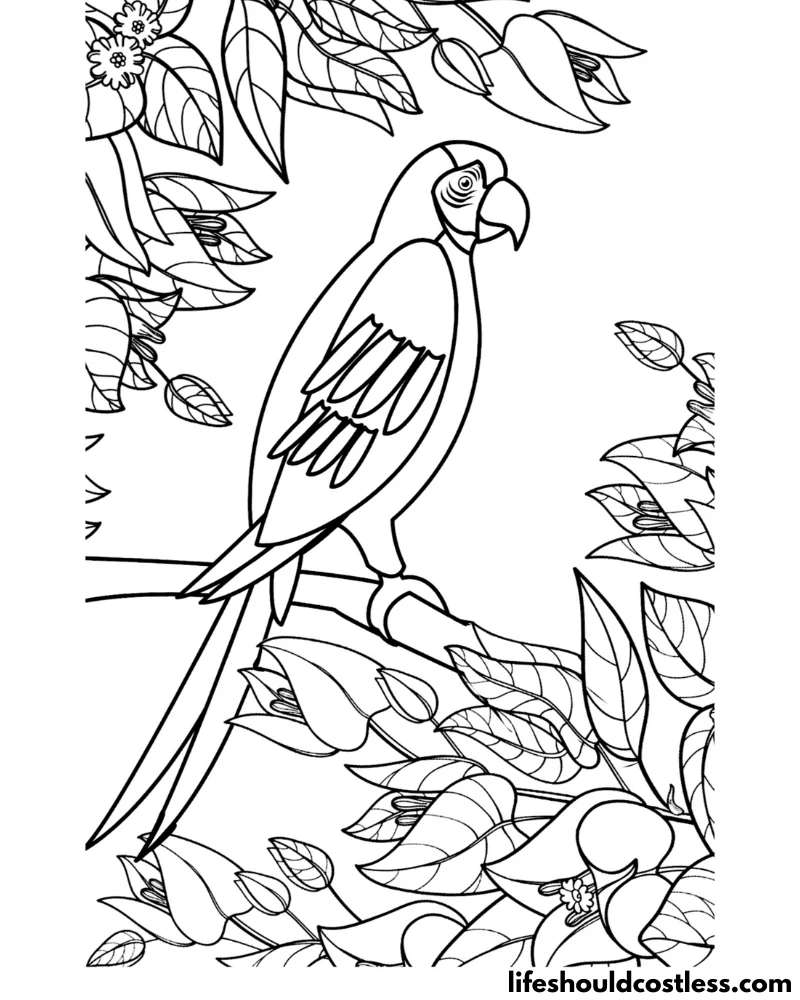
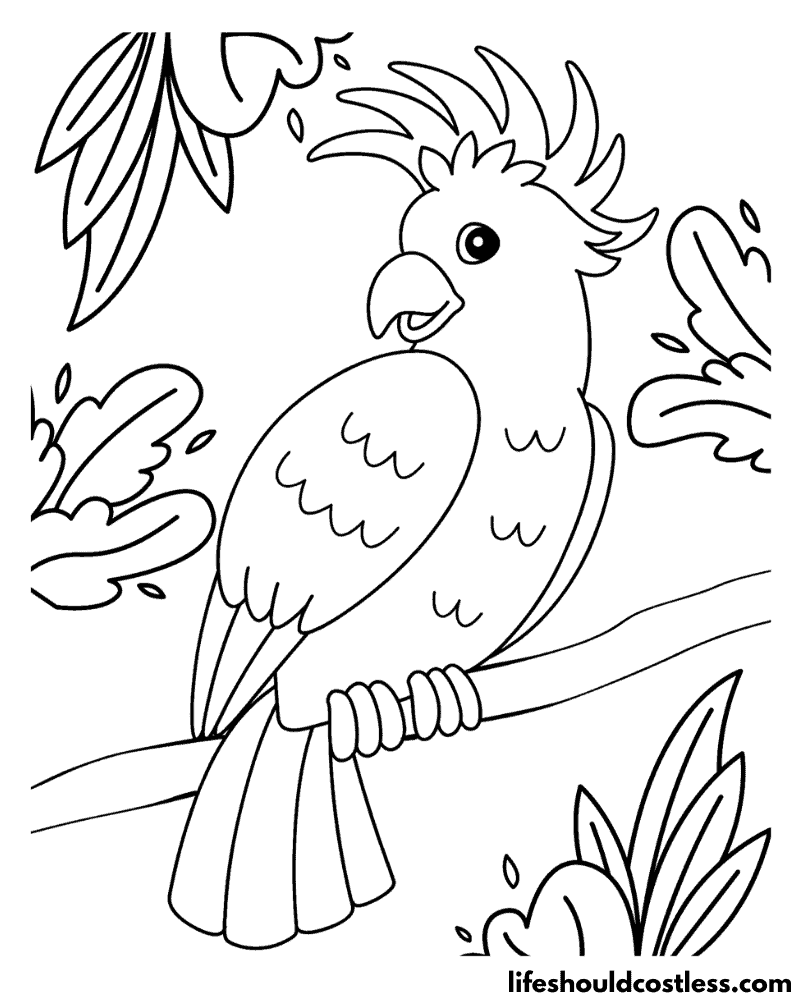
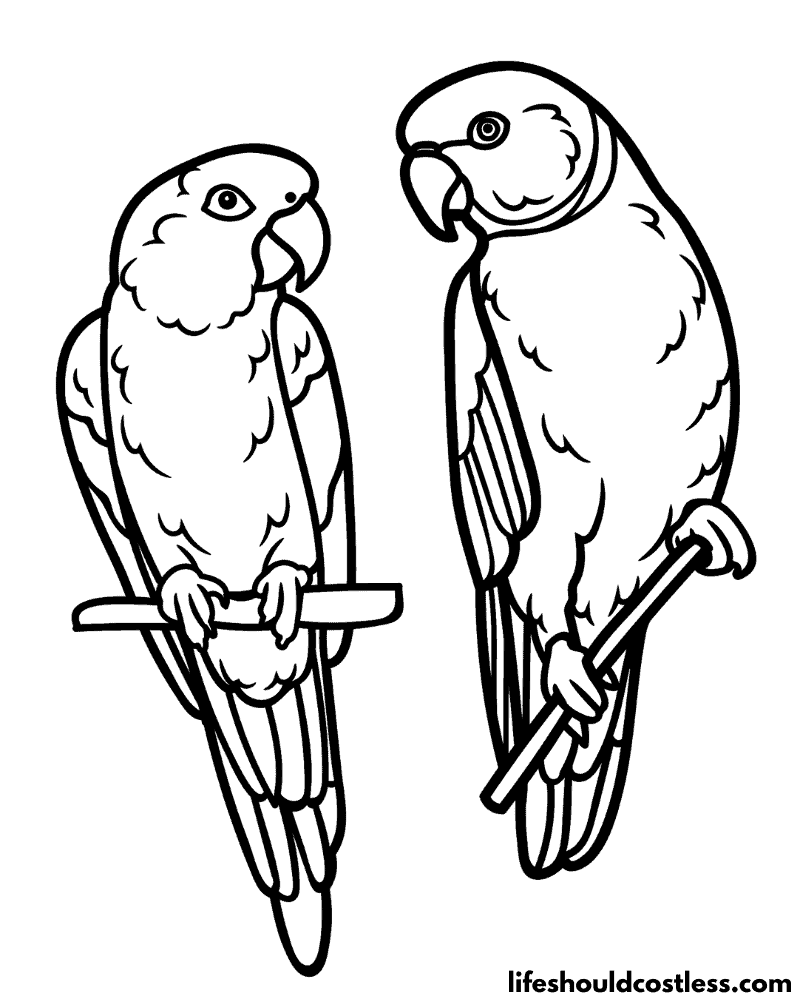
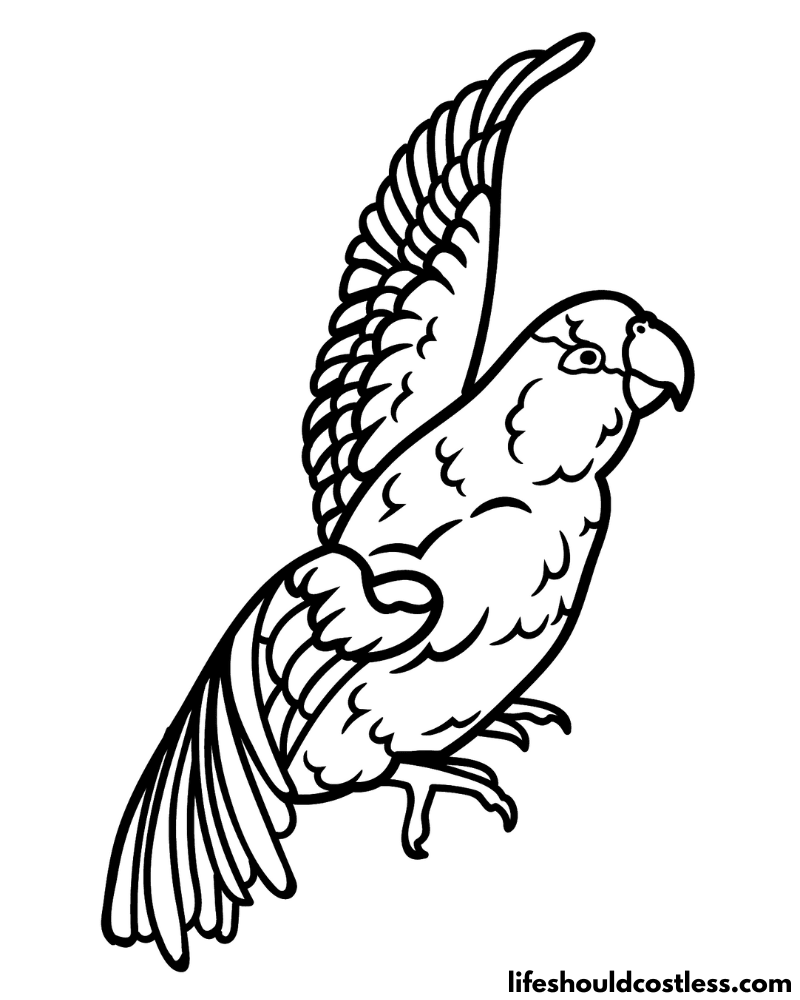
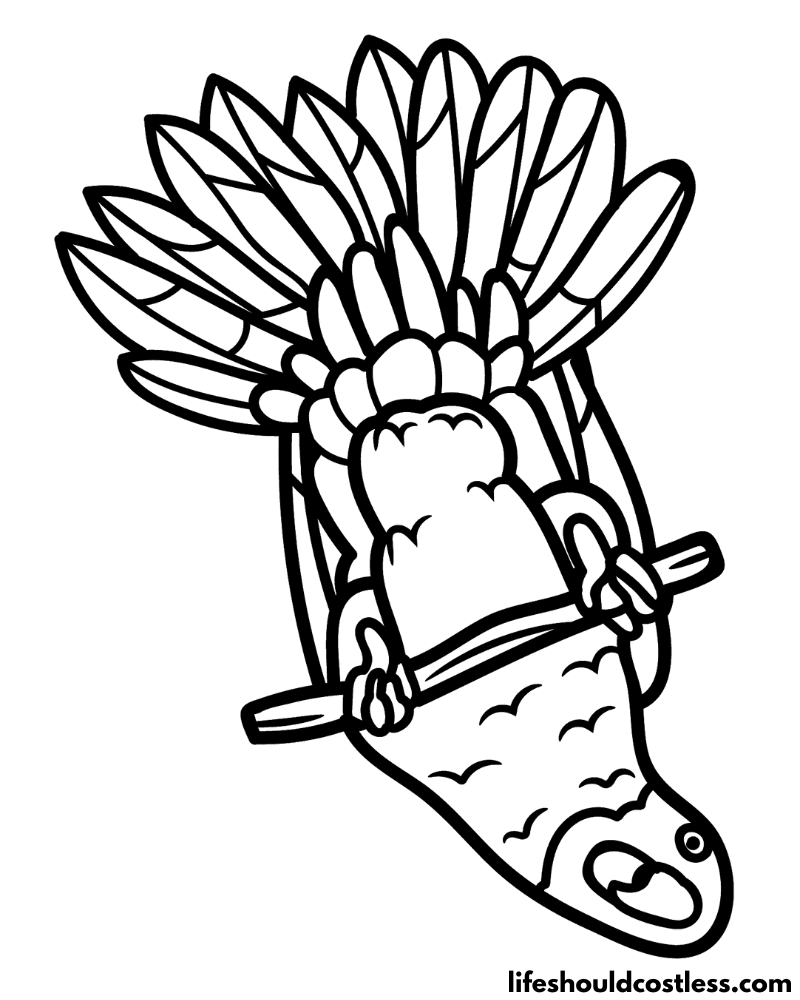
FAQ’s
Wild parrots exhibit a wide array of colors, varying among different species. Here are some common colors you may find in wild parrots:
Green: Many parrot species have predominantly green plumage. Shades of green can range from bright lime green to deep emerald green, allowing parrots to blend in with the lush foliage of their natural habitats.
Blue: Several parrot species showcase beautiful shades of blue. From vibrant electric blue to soft pastel blue, these hues can be found in the feathers of parrots like the Blue-and-yellow Macaw or the Hyacinth Macaw.
Red: Red is another prominent color seen in certain parrot species. Some parrots exhibit vibrant red feathers on their bodies, wings, or tails. The Scarlet Macaw is a well-known example with its striking red, blue, and yellow plumage.
Yellow: Yellow can be found as a primary or secondary color in many parrot species. It may appear as patches, highlights, or undertones in their feathers. The Yellow-headed Amazon and the Sun Conure are examples of parrots with prominent yellow coloration.
Orange: Some parrots display vibrant orange feathers, often in combination with other colors. The Peach-faced Lovebird and the Orange-winged Amazon are examples of parrot species that exhibit orange plumage.
Purple: Certain parrots possess shades of purple or violet in their plumage. These hues can be observed in species like the Violet-necked Lory or the Purple-naped Lory.
Other Colors: Parrots can also exhibit colors such as black, white, gray, and various shades of brown, depending on the species. These colors may appear as markings, patterns, or accents in their feathers.
It’s important to note that the specific colors and patterns vary greatly among the vast number of parrot species found in different regions around the world. Each species has its own unique coloration, helping them adapt to their respective environments and attract mates.
The color of a parrot can vary significantly depending on the species. Parrots come in a wide range of vibrant colors, making them visually striking and beautiful creatures.
Some common colors seen in parrots include green, blue, red, yellow, orange, purple, black, white, gray, and various shades of brown.
However, it’s important to note that not all parrots exhibit every color. The specific coloration and patterns of a parrot are unique to its species and can differ greatly from one species to another.
*I will add more parrot colour / color questions and answers as the questions get sent to me.
In conclusion, exploring the world of parrot coloring pages has undoubtedly provided us with an educationally captivating and enriching experience.
These feathered wonders, with their vibrant colors and unique characteristics, have sparked our imagination and artistic flair.
Through the act of coloring, we have brought these magnificent birds to life, capturing their beauty and essence on paper.
Coloring these illustrations has allowed us to express our individuality and artistic style, bringing out the best of our imagination and talent.
We have experimented with various coloring techniques, blending colors, and adding shadows and highlights to create depth and realism.
Each stroke of color has been an opportunity to infuse life and personality into our artwork.
As we conclude our exploration of parrot coloring, we are reminded of the beauty and diversity of the natural world and the importance of nurturing our creative spirits.
The vibrant colors and captivating charm of parrots have left an indelible impression on our artistic endeavors.
Thanks so much for stopping by my blog and supporting my endeavors to make people’s lives a little easier/better/more affordable. If you liked this post, or found it helpful in any way, please make sure to share it with your family, friends, and co-workers via social media.
Or you could even send them the direct link via email. Whichever way you choose to spread the love, I super appreciate it! ~Sarah
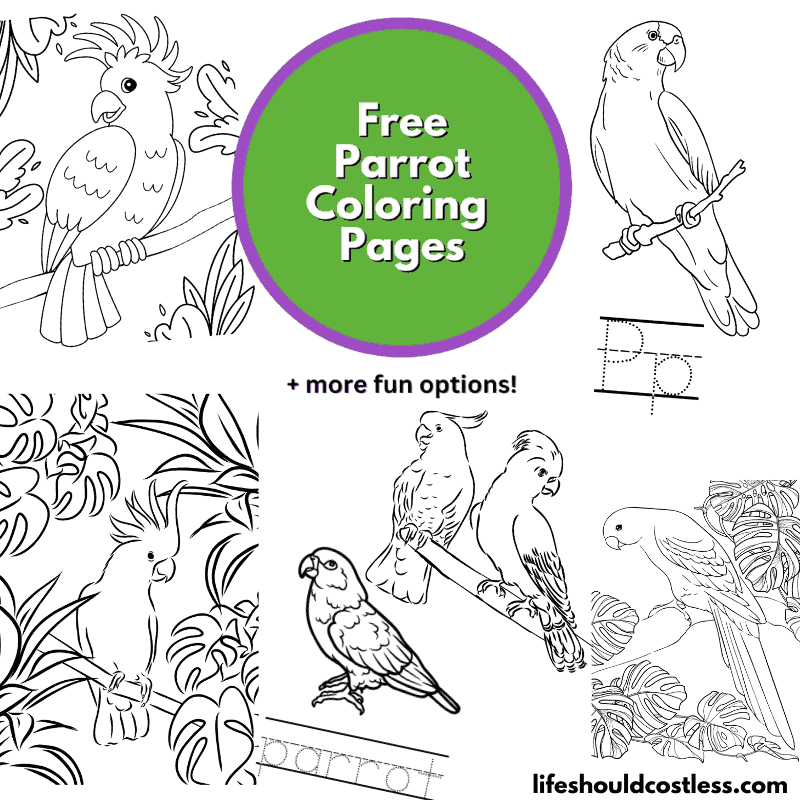
How to follow & support this site
- If you would like to subscribe to my email list, go here.
- Make sure to follow along via social media, by going here.
- If you would like to learn how to really show your support to this site (at no cost to you), go here.
- If you would like to make a direct donation to the site, go here.
Check out my other free printables
- To see all of my free printables, go here.
- To see an alphabetized index of all of my coloring pages, go here.
- To see all of my Animals coloring pages, go here.
- To see all of my Birds coloring pages, go here.
Otherwise, here are direct links to several of my other bird posts that you’re also going to love:
Animals / Birds
Animals / Mammals
Animals / Insects
Other good resources for a printable parrot
- https://www.coloring.ws/parrot-coloring.htm
- https://www.animalstown.com/animals/p/parrot/coloring-pages/parrot-coloring-04.php
- https://www.templateroller.com/template/2607090/parrot-coloring-page.html
*This post was originally shared to this blog on 06/19/2023, and has since been updated to improve user experience, add video instruction, as well as to make it as shareable as possible across the social medias.
**Please note that I do try my hardest to provide factual, but easy to understand, information about each topic. If you notice a discrepancy in my coloring pages, facts, or see something that you deem “misinformation/incorrect” please make sure to notify me about it. I would prefer that you send me an email with a link to a more reputable resource on that subject, so that I can correct it as soon as possible. Thanks so much for helping this site become the best that it can be!
***Resources from djinkers were used in the production of this article.
